| |
|
St Mary,
Weeting
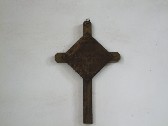 |
|
I
have mentioned David Striker before. There are
several people I know who are currently
undertaking the mildly arduous task of visiting
every medieval church in Norfolk and Suffolk, but
David is the only one of them who lives in
Colorado in the USA. But he used to live in
Brandon, and when he told me he was coming over
here for a couple of weeks and suggested a road
trip, I wondered if we might pick off the
churches which run up through the south-west of
Norfolk from Brandon to Downham Market. The most
southerly of these churches are ones which David
knew well, and, although this is by no means
Norfolk's friendliest area (it is, after all, in
the Ely Diocese) we were expecting a fair number
of open churches, particularly this one. The parish
of Weeting adjoins the Suffolk border - indeed,
some Weetingers live in the northern part of the
Suffolk town of Brandon, which spills into
Norfolk. Brandon Catholic Church and Brandon
railway station are both in the parish of
Weeting. But the medieval parish church is near
the village of Weeting, a couple of miles to the
north. It was soon after nine o'clock, and we
headed out of Suffolk and up the busy road.
|
It's worth
pausing for a moment to wonder why a Church of England
parish might keep its building open during the day.
What's in it for them? Catholic churches, for example,
have a liturgical imperative to be open - the Blessed
Sacrament is reserved, and it is seen as a duty of the
faithful to go in and pray in its presence if they are
passing. Most Anglican churches don't do this (although a
few do) and in any case, anyone insisting on praying in
the Presence of the Sacrament in an Anglican church might
well be frowned upon as an enthusiastic and not
altogether harmless eccentric.
However,
over the last few years, the Church of England seems to
have begun to see its mission in a new light. Rather than
succumb to depression at the possibility of terminal
decline, it has increasingly repositioned itself as being
there for all the people of God rather than just for the
Sunday club. At parish level, this means that the church
needs to be available for anyone who is passing, a
pilgrim or a stranger, who wants to go in and pray, or
grieve, or merely experience a sense of the numinous.
This is particularly important for rural churches with a
graveyard which is still in use, because it enables
visitors to family graves to visit the church as well,
and say a prayer or two if they want. If the church is
locked, then visiting a grave becomes divorced from the
experience of Faith. It becomes a secular activity - or,
even worse, a Pagan one, visitors merely worshipping
their ancestors with propitiatory flowers.
It may
well be that, these days, regular users of a parish
church never attend a Sunday service at all. I've met
several people on my travels who often pop into the
building just to sit for a while, but don't ever go to a
service. In a funny way, it makes me rather optimistic -
they may not have a sense of ownership, but they do have
a sense of belonging, and because of this the Church of
England may outlive its predicted demise.
The great
majority of Norfolk's medieval churches are open all day,
every day, of course, and the Diocese of Norwich
enthusiastically encourages and supports this. Things get
a bit stickier in that part of Norfolk under the rule of
the Diocese of Ely. It may be that Ely doesn't have the
same mission for its parish churches, or it might just be
that they are reluctant to press the point with these
parishes beyond the Cambridgeshire pride lands, but it
remains that there are many more locked churches in this
part of Norfolk than any other. Of course, some of these
locked churches have a notice telling you where to get
the key, but not all of them do. However, David
remembered finding Weeting church open on several
occasions, and so did several other church explorers I'd
asked.
We came up
from the village centre along a rutted track. It was
absolutely pouring with rain - it had been since David
picked me up at Bury station, and the sky was leaden and
heavy. It was not an auspicious start. It was certainly
not possible to get out and photograph the outside of the
church: I wound down the car window, and took the shot at
the top of this page. As you can see, this is a
round-towered church, but a rather crisply-lined one. The
tower dates only from 1868, when the old one was
demolished as a danger. The nave and chancel are older,
but the flint work appears to have been almost completely
redone at about the same date.
I put my
camera under my coat, and we set off to take a look
inside.
I saw the
padlock as soon as I got out of the car. The outer gates
of the porch were bound by a big chain, and with a heavy
heart I trudged up the long path to see if there was a
keyholder notice. There wasn't. Despite the weather, I
was feeling charitable. Many rural Anglicans are elderly;
this church is away from its village centre, and it did
not seem unreasonable to think that the person
responsible for unlocking it had looked out of the
window, assumed that no one in their right mind would be
out church-visiting in this weather, and had decided to
wait for the rain to stop before going up to open the
church. This, however, did not help us much.
We
staggered back through the rain, slipping on the wet
grass. On the edge of the graveyard was a noticeboard.
There wasn't a keyholder notice, but there was one of
those in case of emergency notices which
parishes have been browbeaten into putting up. I found the churchwarden's number and rang
it.
He wasn't terribly pleased to hear
from me. "We keep the church locked. We don't
encourage visitors. We've had lots of trouble. Lots of
things nicked, lots of damage." He had a strong
accent, a reminder that it is still ordinary local people
who keep the Church of England going, not the pen-pushers
in Diocesan House.
I explained who I was, and about
the Norfolk Churches Site, and David having come all the
way from Colorado. He thought for a moment. "I can't
come and open up, it's not convenient. I don't drive, I'm
a retired merchant seaman." At this point, a little
chink of light appeared in my mind. I'm always impressed
by people who don't drive - I'm one myself, and there is
something a little bit different about us. And all
retired merchant seamen I've ever met have been
eccentrics, and eccentrics rarely have closed minds. I
wondered if anyone else would come and open up for us.
"No, I don't want to put anyone else to any bother
in the rain. Who did you say you were? Have you got any
money?" I laughed, and said no, and he laughed too,
and gave in. I suspect that he had heard the voice of the
Ely Diocesan Tourism Officer nagging in the back of his
head, reminding him of his duties as a churchwarden.
"If you come down now, I'll come back with you and
open up".
It always feels good to be trusted by a stranger, and so
we went back down into the village with light hearts to
get him. He had that determined energy you so often find
in ex-servicemen. "I can't understand how anyone can
leave a church open to the public, I never would" he
told us, as he got in David's car. We headed up to the
church. "You wait in the porch", he
said,"I'll turn off all the alarms". He came
back out to get us. "We're smart-watered up to the
eye balls" he said, as he let us in, just in case,
after all this, we still decided to pick up a pew and run
with it.
| It turned out that there
had been a fair amount of petty vandalism, but
the final straw had come when an old altar
frontal, woven by a long-dead but
fondly-remembered member of the congregation, had
offensive slogans scrawled on it in biro. This
was shocking - sacrilege is not the kind of thing
which happens in East Anglia very often. He had
only been in the post a year or so, but he had
decided that the church had to stay locked from
now on. This was sad, but it seemed to me that a
small parish community like this must often feel
a sense of helplessness when faced with the
responsibility of caring for a sacred space in
the face of an attack. The protection of property
is not a Gospel value, but these buildings are
time capsules and touchstones which hold the very
soul of their parishes, and they need to be
preserved if at all possible. Sometimes, it must
seem that locking everybody out is the only way
of accomplishing this. Vandalism of a church
strikes at the very heart of the whole local
community, but the response to it can also have a
deleterious effect. The
church is pretty much all Victorian inside, with
a good 1905 east window. It depicts the
Ascension, and is by George Parlby, probably his
only work in East Anglia. It would be fair to say
that it dominates the church, but this is not
necessarily a bad thing, for the place would be
rather characterless without it.
|
|
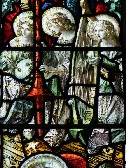 |
There are image niches either side
of the window, which I first took to be a Victorian
pretence, but on closer inspection they are exactly the
same size as the creed boards now in the north aisle.
These date from the early 19th Century, and were almost
certainly designed to cover the niches by
protestant-minded churchwardens of the time. Possibly,
they replaced earlier ones pressed into the same job. The
Decalogue is on a reredos, now also in the north aisle,
but which would once have been in the sanctuary. They
were probably removed in the 1890s, when the current
carved wooden altar and reredos were installed. These are
not particularly exciting, but are interesting because
they were the work of the Rector's wife. There are
several East Anglian churches where the wife of the
incumbent took on restoration work, a fascinating insight
into the mind of the times.
We spent about twenty minutes
chatting with our new friend, and poking about his
church. And then, something rather extraordinary
happened. It seemed that the parish's seventeenth century
silver was en route to its usual home in the treasury at
Ely - it had been shown at an exhibition, and was
currently in the care of the parish. It was due to be
picked up later that day, but while it was still here,
would we be interested in taking a look? We certainly
would. The churchwarden carefully unpacked it, and set it
out on the table.
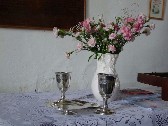 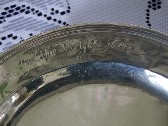 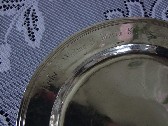
It consists of a paten, which is
the round silver plate used at communion, two chalices
for the wine, and a smaller plate which I took to be a
sub-paten, usually a sign of a sacramentally-minded
congregation. I think that only the paten is 17th
Century, but it has a fascinating inscription on it, Ecclesia
Weeting Maria Sancta Beatae ex dono Judithae Wright 1674:
'The church of Blessed Saint Mary at Weeting, given by
Judith Wright, 1674'. 1674 is a pivotal date in English
church history. It is 14 years after the Restoration of
the monarchy and Church of England, after the long
puritan darkness of the Commonwealth, but it is also
shortly before the so-called Glorious Revolution, when a
coup led by the London merchant classes brought down the
Catholic King James II and replaced him with the
arch-Protestant Dutch prince William of Orange, who
became William III. The Act of Supremacy which
accompanied this coup ensured that the English Crown and
the Anglican Church would remain Protestant, pretty much
forever. This time is a fever of ideas, when the Church
at a parish level was trying to reposition itself after
decades of non-conformist anarchy. We got out the parish
registers, and found Judith Wright's name. She had
married here in the late 1640s, when 'the world turned
upside down', but less than thirty years later she was
donating sacramental vessels with a Latin inscription
refering to the patron of the church as Blessed, in the
Catholic manner.
It was fascinating, and I was glad
we'd seen them before they were locked away in a safe in
Ely again.
We
pottered about a bit more. Beneath the north window in
the north aisle chapel is another curiosity, two simple
piscinas sunk into the sill, side by side. They would
have served an altar here in Medieval days. But why two,
I wondered? Another fascinating detail is the WWI cross
at the west end of the south aisle. These were set
originally on the graves of soldiers killed during the
fighting, to be replaced after the war by marble
headstones provided by the Empire War Graves Commission.
Families could apply to have the temporary wooden cross
sent back to Britain, and many did. This one, unusually,
has a Latin inscription on it, aucto splendore
resurgam, 'but he shall rise again in great
splendor'. The inscription continues In Memory of
11648 Sgt V Malt MM, 7th KSLI, Killed in Action Aug 21st
1918. Victor Malt was a Sergeant in the Seventh
King's Shropshire Light Infantry. He was the son of a Mr
and Mrs H. Malt of Weeting, and the husband of Beatrice
Emma Malt, of 9, Thetford Road, Brandon. When he died, he
was 28 years old. He is buried in Bucquoy Road Cememtery,
Ficheux, near Arras.
| On
the other side of the tower arch is a grandiose
monument in a mock-18th century style. It
remembers John Richard Julius Angerstein, who
died at Holbrook in Somerset in 1925. He is
remembered by his widow Georgiana, whose own
death date of 1945 is noted at the bottom. John
Richard Julius was the last of the Angersteins of
Weeting Hall. The Angersteins were a
Russian family, from St Petersburg, arriving in
Norfolk in 1749. The first of them, who
anglicised his name to John Julius Angerstein,
was a fabulously wealthy merchant. White's 1845
Norfolk Directory notes that he became a
celebrated and wealthy stock broker and
underwriter at Lloyds. He planted here upwards of
1000 acres, was a distinguished patron and
connoisseur of ancient and modern art, and was
the first proposer of State Lotteries in England.
He resided chiefly in Pall Mall, and at the
Woodlands on Black Heath. He died in 1823, and
his valuable collection of paintings were
purchased for the National Gallery, at the cost
of nearly £60,000 - which is to say,
roughly twelve million pounds in today's money.
The Angersteins have gone, and Weeting Hall,
their Norfolk pile, was demolished in 1954.
|
|
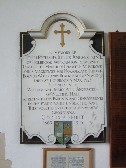 |
|
|
|
